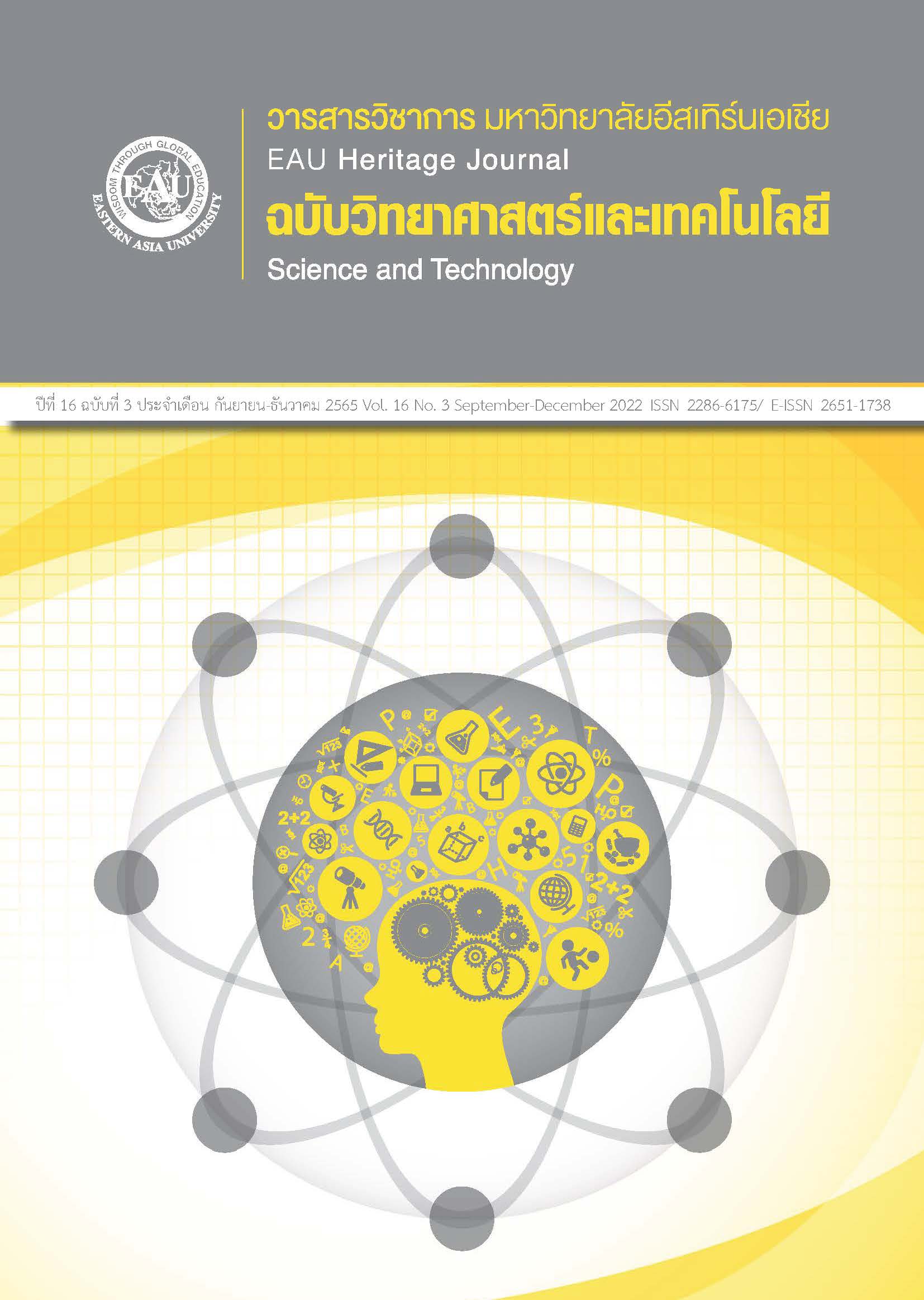การพัฒนาผลิตภัณฑ์บำรุงผิวจากสารสกัดมะเฟือง (Averrhoa carambola L.) ในรูปแบบไมโครอิมัลชัน
คำสำคัญ:
อิมัลเจล, ไมโครอิมัลชัน, สารสกัดมะเฟือง, สารต้านอนุมูลอิสระบทคัดย่อ
มะเฟืองเป็นแหล่งของสารต้านอนุมูลอิสระที่ดีมากแหล่งหนึ่งและยังไม่มีงานวิจัยเกี่ยวกับการนำสารสกัดมะเฟืองมาพัฒนาเป็นผลิตภัณฑ์บำรุงผิว โครงงานวิจัยนี้จึงสนใจนำสารสกัดมะเฟืองมาพัฒนาเป็นผลิตภัณฑ์บำรุงผิวในรูปแบบอิมัลเจล โดยศึกษาฤทธิ์ในการต้านอนุมูลอิสระของสารสกัดด้วยวิธี DPPH พัฒนาสารสกัดมะเฟืองให้อยู่ในรูปแบบไมโครอิมัลชันโดยการสร้างแผนภาพวัฏภาคไตรภาคเทียม นำไปพัฒนาต่อให้อยู่ในรูปแบบอิมัลเจล จากการศึกษาความคงตัว พบว่า สารสกัดมะเฟืองร้อยละ 1–5 มีความสามารถในการกำจัดอนุมูลอิสระร้อยละ 48.33–88.48 โดยมีค่า IC50 เท่ากับร้อยละ 1.062 โดยปริมาตร ไมโครอิมัลชันที่เหมาะสมประกอบด้วยสารสกัดมะเฟืองร้อยละ 20 ไอโซโพรพิลแอลกอฮอล์ร้อยละ 5 โจโจบาออยล์ ร้อยละ 25 สแปน 80 ร้อยละ 25 และทวีน 80 ร้อยละ 25 ตำรับอิมัลเจลที่มีสารสกัดมะเฟืองในรูปแบบไมโครอิมัลชันร้อยละ 2.5–7.0 มีความคงตัวที่อุณหภูมิห้องและสภาวะเร่งทั้งสัมผัสแสงและไม่สัมผัสแสงมีความเป็นกรด-ด่างอยู่ในช่วง 5.87-6.05 และมีค่าความหนืดอยู่ในช่วง 73x103-184x103 เซนติพ้อยต์ ดังนั้นตำรับอิมัลเจลที่มีสารสกัดมะเฟืองใน
รูปแบบไมโครอิมัลชันนี้สามารถนำไปใช้พัฒนาเพื่อเป็นผลิตภัณฑ์บำรุงผิวต่อไป
เอกสารอ้างอิง
Burns, J., Rivers, J. M., & Machlin, L. J. (1987). Third conference on vitamin C. In Conference on Vitamin C 1986: New York, NY. New York: Academy of Sciences.
Chang, J. M., Hwang, S. J., Kuo, H. T., Tsai, J. C., Guh, J. Y., Chen, H. C., & Lai, Y. H. (2000). Fatal outcome after ingestion of star fruit (Averrhoa carambola) in uremic patients. American Journal of Kidney Diseases, 35(2), 189-193. https://doi.org/10.1016/s0272-6386(00)70325-8
Gu, Z. P., Zhang, S. M., Wang, C. L., Lian, W. Y., Xiao, P. G., & Chen, J. M. (1997). Determation of strychnine and brucine in Strychnos by HPLC. Yao xue xue bao= Acta pharmaceutica Sinica, 32(10), 791-794. PMID: 11596226.
Greul, A. K., Grundmann, J. U., Heinrich, F., Pfitzner, I., Bernhardt, J., Ambach, A., Biesalski, H. K., & Gollnick, H. (2002). Photoprotection of UV-irradiated human skin: an antioxidative combination of vitamins E and C, carotenoids, selenium and proanthocyanidins. Skin Pharmacology and Applied Skin Physiology, 15(5), 307–315. https://doi.org/10.1159/000064534
Janyaprasert, W. (2012). Nanotechnology in skin delivery (4th ed.) Bangkok: Chum Chum Printing House Agricultural Cooperatives of Thailand Limited. (in Thai)
Junyaprasert, V. (2009). Nanotechnology: Skin delivery of drugs and cosmetics. Bangkok: Prachachon. (in Thai)
Khanam, Z., Sam, K. H., Zakaria, N. H. B. M., Ching, C. H., & Bhat, I. U. H. (2015). Determination of polyphenolic content, HPLC analyses and DNA cleavage activity of Malaysian Averrhoa carambola L. fruit extracts. Journal of King Saud University-Science, 27(4), 331-337. https://doi.org/10.1016/j.jksus.2015.01.004
Krasantisuk, S., & Runnarong, H. (2006). The development of skin care sericin lotion. The Southern College Network Journal of Nursing and Public Health, 4(3), 249-258. (in Thai)
Masuda, T., & Jitoe, A. (1994). Antioxidative and antiinflammatory compounds from tropical gingers: Isolation, structure determination, and activities of cassumunins A, B, and C, new complex curcuminoids from Zingiber cassumunar. Journal of Agricultural and Food Chemistry, 42, 1850-1856. https://doi.org/10.1021/jf00045a004
Saikia, S., Mahnot, N. K., & Mahanta, C. L. (2015). Optimisation of phenolic extraction from Averrhoa carambola pomace by response surface methodology and its microencapsulation by spray and freeze drying. Food chemistry, 171, 144–152. https://doi.org/10.1016/j.foodchem.2014.08.064
Shui, G., & Leong, L. (2006) Residue from star fruit as valuable source for functional food ingredients and antioxidant nutraceuticals. Food Chemistry, 97, 277-284. http://dx.doi.org/10.1016/j.foodchem.2005.03.048
Sohail, M., Naveed, A., Abdul, R., Gulfishan, Muhammad Shoaib Khan, H., & Khan, H. (2018). An approach to enhanced stability: Formulation and characterization of Solanum lycopersicum derived lycopene based topical emulgel. Saudi Pharmaceutical Journal: SPJ: The Official Publication of the Saudi Pharmaceutical Society, 26(8), 1170–1177. https://doi.org/10.1016/j.jsps.2018.07.005
Tanaji, D. N. (2018). Emulgel: A comprehensive review for topical delivery of hydrophobic drugs. Asian Journal of Pharmaceutics, 12(02), s382-s393. https://doi.org/10.22377/ajp.v12i02.2366
Vertuani, S., Angusti, A., & Manfredini, S. (2004). The antioxidants and pro-antioxidants network: An overview. Current Pharmaceutical Design, 10(14), 1677–1694. https://doi.org/10.2174/1381612043384655
Vinson, J. A.; Dabbagh, Y. A., Serry, M. M., & Jang, J. (1995). Plant flavonoids, especially tea flavonols, are powerful antioxidants using an in vitro oxidation model for heart disease. Journal of Agricultural and Food Chemistry, 43, 2800-2802. https://doi.org/10.1021/jf00059a005







